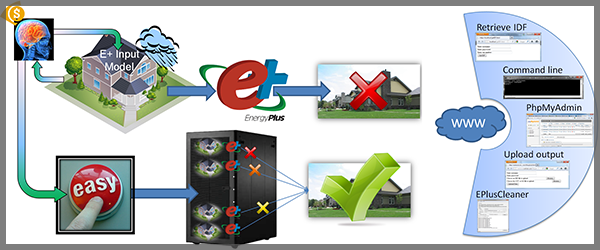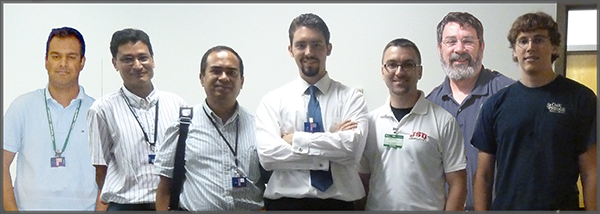INDUSTRY
Supercomputer-assisted Calibration Methodology Enhances Accuracy of Energy Models
Most people appreciate a bargain, an advantageous purchase that affords the customer value (such as convenience and comfort) at minimal cost. Improved energy efficiency equates to a bargain that can deeply impact a household or business budget, as well as a nation’s economy and security.
Awareness of the significance of sustainable energy practices that preserve finite resources for future generations is growing as the entire world faces the formidable challenge of developing and implementing strategies that will stem the increases in power consumption that are expected to occur during the next two decades.
Buildings and the Growing Demand for Energy
The world energy demand is rebounding after recovery from the global economic recession of 2008–2009 and will continue to grow, the U.S. Energy Information Administration (EIA) reports in its publication titled International Energy Outlook 2011. In fact, EIA states, the world marketed energy consumption expands by 53 percent from 2008 to 2035, with Asian countries—particularly China and India—leading the way; their combined energy demand is expected to more than double, collectively accounting for 31 percent of the total world energy consumption in 2035 [1].
Worldwide, buildings are major energy consumers, and consequently they represent an opportunity for both economic and environmental improvements through retrofitting and designing for optimal energy efficiency. Underscoring the possibilities are projections that 60 percent of potential urban building floor space in China [2], and 70 percent of such space in India [3], remains to be built between now and 2030.
While the U.S. contains 5 percent of the world’s population [4], it consumes 19 percent of global energy production [5]. Buildings in the U.S. use 41 percent of the country’s primary energy [5]. Similarly, in most of the other countries of the world, buildings consume 30 percent to 40 percent of the energy [6].
On the positive side, buildings don’t just use a lot of energy, they also perform the role of serving as deployment platforms for renewable-energy applications, including day lighting, solar water heating, photovoltaic electricity generation, and geothermal (ground-source) space conditioning and water heating [7].
Energy Modeling and Simulation
One way to improve the energy efficiency of buildings is modeling and simulation. Energy models are representations of buildings applied in simulations, which consist of design and operating parameters associated with energy consumption. Those parameters can be such things as cooling and heating equipment details, window performance values, installed electricity for lighting and user equipment, ventilation and others.
Energy models have been employed in devising the optimal weatherization package for millions of low-income houses; determining the optimal return-on-investment for building retrofit; and informing policy decisions and tax incentives at local, utility, state and federal levels.
A number of energy-modeling computer applications exist—such as EnergyPlus, eQuest, Trane TRACE and others—and creating the models isn’t difficult. However, making energy models that are accurate is a major challenge.
“Getting energy building models right is so hard because the thousands of input parameters for each building cause even calibrated models created by experts using official measurement and validation guidelines to differ from monthly utility bills by 30 percent to 93 percent [8],” says Joshua New of the Building Technologies Research and Integration Center (BTRIC) at Oak Ridge National Laboratory (ORNL). BTRIC focuses on developing ways to reduce the energy consumption of the nation’s buildings and the resulting carbon emissions essential to sustainability.
Guideline 14 of ASHRAE (American Society of Heating, Refrigerating and Air-conditioning Engineers) specifies a maximum normalized mean bias error for monthly energy use of 5 percent to be acceptable for use in building codes and tax-related performance criteria.
“The cost required to collect data and tune a model to such accuracy involves so much manual effort that it is rarely employed—outside of research—for energy-service company projects smaller than $1 million,” New says. “An automated methodology for model calibration that realistically adjusts input parameters would eliminate risk from energy savings estimates and open up new business opportunities and energy-savings performance contracts in the light commercial and residential sectors. A cost-effective methodology that can meet Guideline 14 requirements is estimated to lead to a cumulative U.S. energy savings of 27.4 TBtus per year, or $1.6 billion annually.”
Autotune and High-performance Computing (HPC)
New and ORNL colleague Jibo Sanyal are leading a research project focused on developing just such a methodology. Their project, called Autotune, is an advanced analytical and optimization methodology that leverages terabytes of HPC-generated simulation data and data mining with multiple-machine learning algorithms for quickly calibrating a building energy model to measured (utility or sensor) data.
Allocations of compute time on the Nautilus supercomputer from the National Science Foundation-funded Extreme Science and Engineering Discovery Environment (XSEDE) are making the Autotune project possible. Housed at ORNL, Nautilus is managed by the University of Tennessee’s National Institute for Computational Sciences (NICS). The Center for Remote Data Analysis and Visualization (RDAV) of NICS is providing HPC consultative services to New and Sanyal’s team.
The Autotune project is, in fact, one of Nautilus’ biggest users, having clocked approximately 300,000 service units, or compute hours, so far. New says his project has employed Nautilus to run about 75 percent of the simulations for warehouse and 100 percent for retail buildings, two of the most popular types, as categorized by square-footage use in the U.S.
“This project has completed about 1.6 million parametric simulations of the eventual 8 million, generating more than 50TB of data of the planned 270TB,” New says.
The components of the Autotune methodology are a simulation engine executable file, simulation input files, sensor utility data, and a mapping between simulation output and sensor or utility data. The output is a calibrated simulation input model.
“The numerical techniques themselves are domain-agnostic and could be used to calibrate inputs for any virtual model to match experimental data,” New says.
New and Sanyal have already adapted Autotune for the National Energy Audit Tool (NEAT) simulation engine computer program. NEAT was developed at ORNL for DOE’s Weatherization Assistance Program to assist state and local agencies in determining the most cost-effective retrofit measures for low-income, single-family homes to increase the comfort of occupants and reduce monthly utility costs.
The Autotune researchers plan to deploy the methodology as a desktop application, website and web service. In addition, New says all the HPC-calculated data emanating from the project are shared publicly online as part of an “open science” approach that allows citizen scientists and institutions to download and analyze the data for their own purposes. The data can be accessed through the Autotune website.

The results of all Autotune experiments, New explains, are reproducible and uploaded to the server for investigation of each experiment’s performance using interactive visualization provide by Tableau (business intelligence software) on the Autotune dashboard.

As the world applies energy modeling in its quest to attain cost savings, security and sustainability in the decades ahead, the Autotune methodology will place the bargain of energy efficiency within reach for more commercial and residential buildings.
Websites
References
- International Energy Outlook 2011 from the U.S. Energy Information Administration (Report Number: DOE/EIA-0484 [2011])
- OECD Environmental Outlook to 2030 from the Organisation for Economic Co-operation and Development
- “Energy and Buildings in India: Setting a Course for Efficiency” from Institute for Building Efficiency
- "U.S. & World Population Clocks" from the United States Census Bureau
- Buildings Energy Data Book from the U.S. Department of Energy
- Buildings and Climate Change: Status, Challenges and Opportunities from the United Nations Environment Programme, 2007
- ORNL Building Technologies Research & Integration Center website
- Energy Performance Score 2008 Pilot: Findings and Recommendations Report, August 2009, prepared for Energy Trust of Oregon by Earth Advantage Institute and Conservation Services Group
